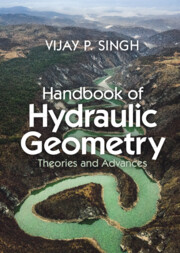Book contents
- Handbook of Hydraulic Geometry
- Handbook of Hydraulic Geometry
- Copyright page
- Dedication
- Contents
- Preface
- Acknowledgments
- 1 Introduction
- 2 Governing Equations
- 3 Regime Theory
- 4 Leopold–Maddock (LM) Theory
- 5 Theory of Minimum Variance
- 6 Dimensional Principles
- 7 Hydrodynamic Theory
- 8 Scaling Theory
- 9 Tractive Force Theory
- 10 Thermodynamic Theory
- 11 Similarity Principle
- 12 Channel Mobility Theory
- 13 Maximum Sediment Discharge and Froude Number Hypothesis
- 14 Principle of Minimum Froude Number
- 15 Hypothesis of Maximum Friction Factor
- 16 Maximum Flow Efficiency Hypothesis
- 17 Principle of Least Action
- 18 Theory of Minimum Energy Dissipation Rate
- 19 Entropy Theory
- 20 Minimum Energy Dissipation and Maximum Entropy Theory
- 21 Theory of Stream Power
- 22 Regional Hydraulic Geometry
- Index
- References
20 - Minimum Energy Dissipation and Maximum Entropy Theory
Published online by Cambridge University Press: 24 November 2022
- Handbook of Hydraulic Geometry
- Handbook of Hydraulic Geometry
- Copyright page
- Dedication
- Contents
- Preface
- Acknowledgments
- 1 Introduction
- 2 Governing Equations
- 3 Regime Theory
- 4 Leopold–Maddock (LM) Theory
- 5 Theory of Minimum Variance
- 6 Dimensional Principles
- 7 Hydrodynamic Theory
- 8 Scaling Theory
- 9 Tractive Force Theory
- 10 Thermodynamic Theory
- 11 Similarity Principle
- 12 Channel Mobility Theory
- 13 Maximum Sediment Discharge and Froude Number Hypothesis
- 14 Principle of Minimum Froude Number
- 15 Hypothesis of Maximum Friction Factor
- 16 Maximum Flow Efficiency Hypothesis
- 17 Principle of Least Action
- 18 Theory of Minimum Energy Dissipation Rate
- 19 Entropy Theory
- 20 Minimum Energy Dissipation and Maximum Entropy Theory
- 21 Theory of Stream Power
- 22 Regional Hydraulic Geometry
- Index
- References
Summary
This chapter employs the theory comprising the principle of maximum entropy (POME) and the principle of minimum energy dissipation or its simplified minimum stream power for deriving hydraulic geometry relations. The theory leads to four families of downstream hydraulic geometry relations and eleven families of at-a-station hydraulic geometry relations. The principle of minimum energy dissipation rate states that the spatial variation of the stream power of a channel for a given discharge is accomplished by the spatial variation in channel form (flow depth and channel width) and hydraulic variables, including energy slope, flow velocity, and friction.
Keywords
Information
- Type
- Chapter
- Information
- Handbook of Hydraulic GeometryTheories and Advances, pp. 491 - 509Publisher: Cambridge University PressPrint publication year: 2022
